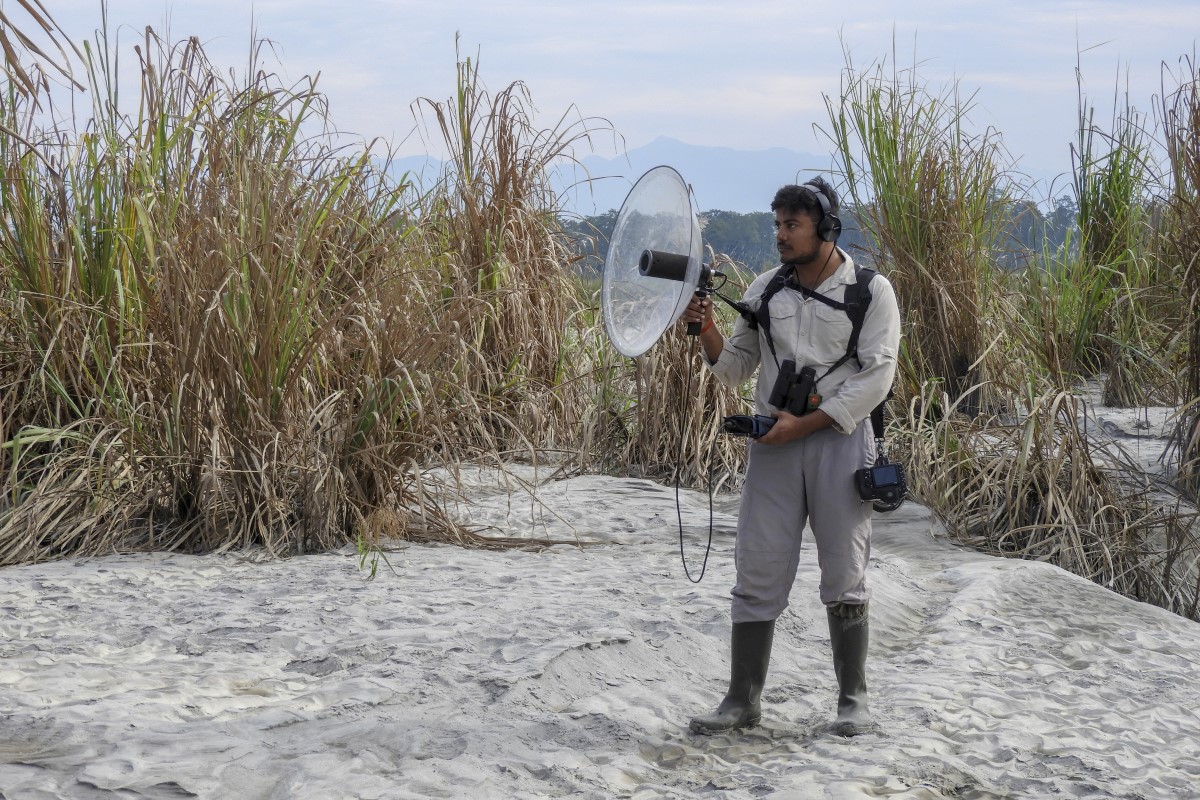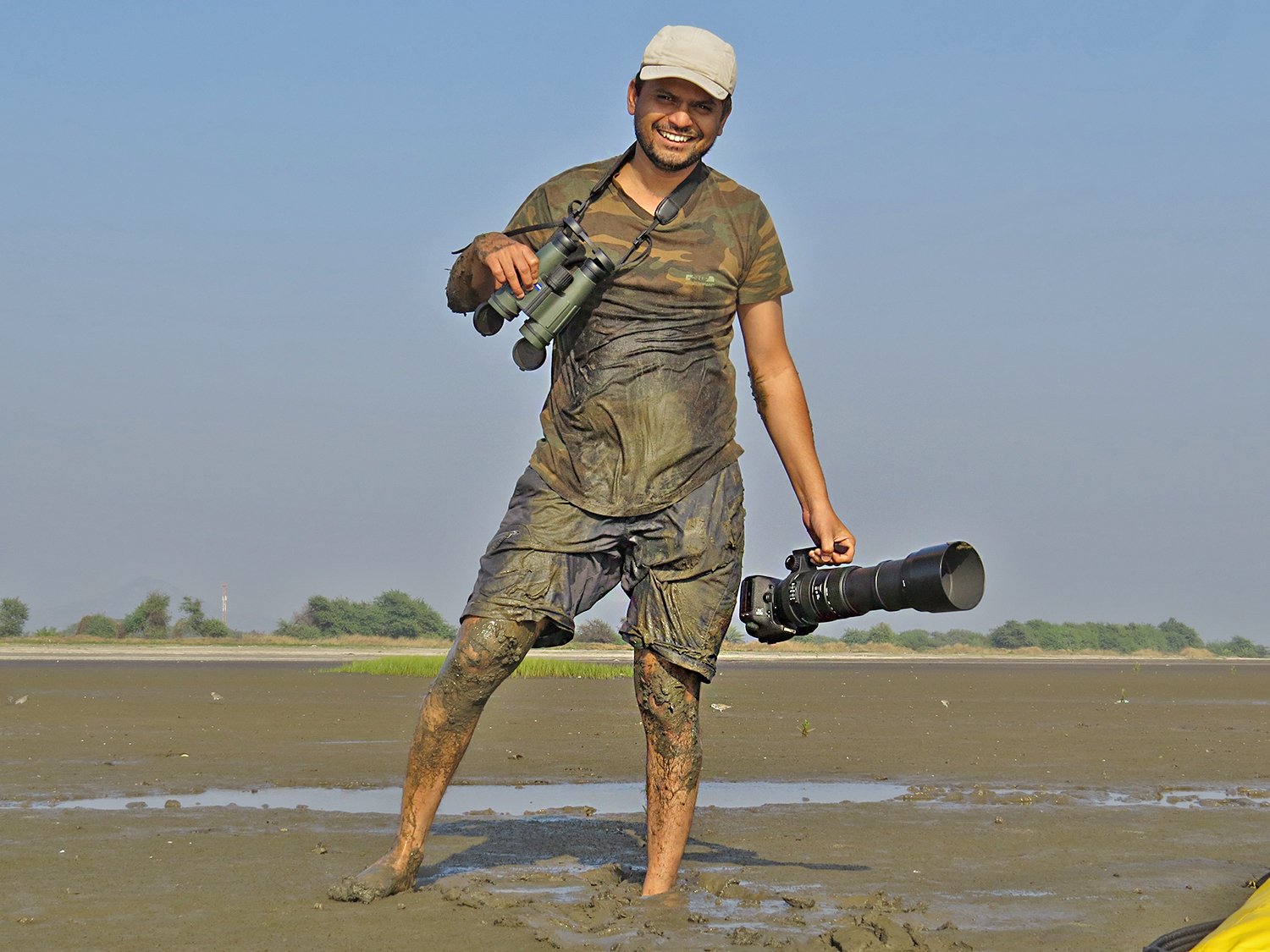Birding Gear
First published in Sanctuary Asia,
Vol. 40
No. 10,
October 2020
By Shashank Dalvi
When I began birding in the 1990s, all I had was a pair of binoculars and a field notebook on which I would hastily scribble descriptions. The lack of good birding guides led me to pore over heavy volumes of the Handbook of the Birds of the Indian Subcontinent and peer at the collections of specimens at the Bombay Natural History Society to identify my sightings. But by the turn of the century, birding had been revolutionised and I began to rely heavily on the variety of new equipment. Most good birders carry high quality binoculars and cameras to the field. And if one learns to use these and other tools well, and stay sharp while birding in the field, the cornucopia of useful gadgets will undoubtedly enhance the birding experience.
Spotting Scopes and Binoculars

Ace birder, photographer and birdcall recordist Saurabh Sawant uses a directional parabola and recorder to isolate and record bird sounds in the Daying Ering Memorial Wildlife Sanctuary, Arunachal Pradesh. Photo: Shashank Dalvi
Late one evening, I was birding with some friends in a tea estate beside a small bamboo grove on the outskirts of the Kaziranga National Park. The estate was located in the lowland evergreen forests of the Assam plains. We had already seen Buff-chested Babblers, a Pale-chinned Flycatcher, an attractive White-browed Piculet, a babbling group of Lesser, Greater and Rufous-necked Laughingthrushes and more. But our main quarry for the evening was that master skulker, the Blue-naped Pitta, which can be notoriously difficult to find. We were just about to call it a day when I heard a loud and plaintive ‘pUU/WHEET’! Five minutes of silence and then the bird called again. The pitta was nearby and closing in, but the light was fading fast. We positioned ourselves on the edge of the tea bushes overlooking a small gully filled with dense bamboo clumps, binoculars ready. After a few anxious seconds, a dull brown-coloured bird finally appeared, hopping onto a bamboo, just about visible in the deepening dusk. It stood there for a couple of seconds, poised, and then hopped once again. Everyone gasped. The pitta jumped into the next bamboo
clump and as we turned to follow the bird, it all went dark.
If not for the excellent assortment of Zeiss, Leica and Swarovski binoculars we possessed, there would have been little chance of locating this elusive bird in the fading light. The importance of equipment with high-quality optics cannot possibly be overstated for serious birders. This is equally true for binoculars as well as spotting scopes, the latter being irreplaceable when scanning for birds at long distances. Spotting scopes can also help study moult patterns in birds and enable one to observe fascinating behaviour from a distance without disturbing the birds.
Bird Calls and Songs

A pair of binoculars, a whistle, laser pointer, smartphone, powerful torchlight and a good camera are some of the essentials while out birdwatching, suggests the author, a veteran birder for the past four decades. Photo: Shashank Dalvi
On my first visit to Northeast India, almost nothing was known about the birds of Eastern Himalaya or South Assam Hills. The little that I gathered was from museum specimens and some sketchy distribution reports. There was next to no information on bird sounds until Xeno-Canto (a website dedicated to sharing bird sounds from across the world) gave that opportunity to birders. The only way to identify birds by sound back then was to wait patiently and follow the song to their owners. Since sightings were not always possible, birders also recorded songs on tape recorders to try and find the vocalist at another opportunity. Later on, cassette recorders gave way to mini-disc recorders which would rewrite a small index of all recordings each time a new recording was made. However, these indices sometimes
malfunctioned while rewriting, and much to my dismay, I have lost many vital recordings on more than one occasion.
Within two years of my first trip to the Northeast, mini-discs were replaced by digital recorders and that was a huge relief. The technological juggernaut has since rolled forward, and today, we can record bird songs on cell phones. Though they lack the audio quality of professional recorders, technology will surely catch up soon. But I must add that my earliest experiences, carrying cumbersome recorders, mics and parabolas taught me to focus on bird calls and songs, to which I greatly attribute my growth as a birder.
This in fact is what led to the discovery of the Himalayan Thrush. Our ears noted the difference in the song of the thrush from its closest relative, but it was the recording equipment that eventually helped us nail down, document and accurately describe the species that was ‘hiding in plain sight’.
Other Must-Have Essentials
Other than binoculars (I would suggest carrying two, because you don’t want to waste a trip if one gets damaged!), essentials in my inventory include a whistle, a laser pointer, a smartphone, a powerful torchlight and a good camera. The whistle is a surprisingly useful tool. Often when I want to grab the attention of fellow birders during a difficult sighting, the whistle comes in handy and ensures I don’t disturb the bird. Ditto with the laser pointer. It is the quickest way to point a bird out to fellow birders without talking or gesticulating. I hasten to add that the responsible use of such tools is key to being a serious birder. Never point the laser straight at the bird, just somewhere near it. These days most smartphones can do things that
required multiple tools in the past. If I want to refer to a field guide, it can be done by using various applications. It helps in making notes, listing species and the number of individuals observed, recording calls and more. A good torch is vital to birding. I like to get to the best birding spots at the crack of dawn so I can start birding at first light. Sometimes I continue until after dusk to look for nocturnal birds. In both cases, when traversing unfamiliar habitats in the dark, a torch, is a very useful device.
Depending on the species that I want to observe, I sometimes carry a portable hide with me as well. Of course, the camera has now become a quintessential tool. Little understood by those starting out, Google Earth is another invaluable resource that greatly helps me study and understand the habitat well before my birding trip. The types of equipment I carry often changes depending on the habitats I explore online.
Having said all of this, and listed a variety of gadgets, I know that what
a birder really wants is to go out and enjoy birds. For this, I would say to Sanctuary readers that a good pair of binoculars should remain the first weapon of choice.
BIRDING essentials:
GPS (most smart phones have these now)
Pocket knife
Flashlight
Water bottle
Weatherproof notebook (most smart phones have now replaced
the need of notebook)
A good pair of walking/hiking shoes
Extra pair of socks
A rain jacket (particularly during the monsoon) or a fleece jacket (during the winter).
Binoculars: Today, low-cost binoculars can try and equal the performance of models many times more expensive. However, they all fall short in low light conditions. There are many sites and reviews for different models. In India, the range of available binoculars is no longer limited and one can now find many models online. We recommend 8x42 or 10x42 specifications, where the first number is the magnification and the second is the diametre of the object lens in millimetres, effectively giving field of view. These are also optimum for detail, weight and steadiness. Remember that greater magnifications are more difficult to hold steady. For birding, we recommend the following basic characteristics in binoculars: water or weather resistant, and a warranty and service centre in India.
Spotting Scope: Spotting scopes allow you to observe much closer than binoculars, though finding a bird in the field of view needs practice. In spotting scopes, you generally get what you pay for, hence buy the most expensive you can afford. When buying a scope keep the following in mind: get a zoom between 20x to 45x with an objective lens of about 60-80 mm.; stay towards the larger size if digi-scoping. However, scope with fixed zoom gathers light better than the scope with zoom; get a stable tripod; and as with binoculars, ensure service and weather proofing in India if possible.
Camera: The range is vast when it comes to cameras for birding. so generically we recommend at the very least a bridge camera with a long zoom of at least 400 mm. Whereas a DSLR/mirrorless camera should have a telephoto of at least 300 mm., though more if greater detail is required.
Ace birder and naturalist, Shashank Dalvi has been involved in the discovery of the mass hunting of Amur Falcons in Nagaland resulting in an international conservation campaign and the discovery of the Himalayan Forest Thrush.



